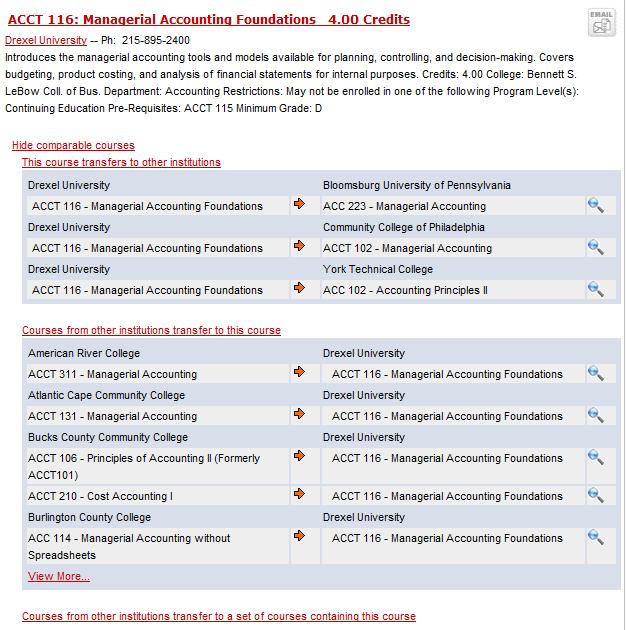This is a review of how you can take summer courses and transfer the credits back to your home institution. Find comparable and equivalent courses and get approval first. If you simply want to find courses with equivalencies back to your home institution (where you are presently enrolled in a degree program) either full-time or part-time, follow these general steps after you meet with your academic advisor and before you register.
| Step 1: |
Find an equivalent course searching your home (current) institution's course offerings. The search results would show the course and you can drill down on comparable courses.

Or, Search for Equivalencies to find a course that is equivalent to the requirement you need to fulfill at your home institution. Search your institution's catalog by entering your school name. The courses offered will display. Then select the course you seek to take from other schools that is comparable.
Or, Download our mobile app Academic GPS to search for classes on the fly. It's available for iPhone, Windows Phone 7 and Android users. Search your institution's course offerings to find comparable courses in the palm of your hand.
Remember placement testing or prerequisite courses may be required.
|
| Step 2: |
Check with your academic advisor or college Registrar concerning your college’s academic and transfer policies. You can also find transfer policies for most institutions on their Transfer Profile. For instance, many colleges only transfer courses with a grade of C or better and do not allow students to repeat courses at other institutions. Knowing these policies ahead of time may save you time, money and frustration in the long run. |
| Step 3: |
Obtain written approval. As a guest student, you will most likely need to receive written approval from your home institution before scheduling courses at your transfer institution. |
| Step 4: |
If required, apply for admission. At some institutions, students must apply for admission before registering for classes. A call to your transfer institution’s Admission Office or Registrar/Registration Office should tell you whether admission is required. |
| Step 5: |
Complete all appropriate forms. Some institutions require guest students to complete a guest student course approval form before registering. Check with the transfer college Registrar or Registration Office and complete any forms that may be required.
|
| Step 6: |
Register for classes and pay tuition and fees. Check your transfer college's website and catalog for registration information and payment deadlines. |
| Step 7: |
Discuss financial aid options. Guest students are generally not eligible for financial aid through the transfer institution. However, a student may be eligible for financial aid through his/her home institution.
For more information, contact the Financial Aid Office at your home institution and request that a Consortium Agreement be processed.
A Consortium Agreement is a contract between two colleges that helps to determine financial aid eligibility, while ensuring that any financial aid is processed through the home institution. |
| Step 8: |
Obtain a photo ID and parking permit. You may be required to obtain a photo ID specific to your new college. Again, it is up to you to contact the transfer college’s student services office or campus police for more information. |
| Step 9: |
Request an official transcript. To properly transfer credit back to your home institution, you must request an official transcript be sent from the transfer institution to your home institution. Remember, this is not an automatic process and your coursework will not transfer until a transcript is sent and evaluated! |
| Written by AcademyOne's CEO and Founder David K. Moldoff who has worked in higher education for over thirty five years developing student centered enrollment systems since the 70's. Mr. Moldoff graduated from Drexel University through the cooperative education program and majored in economics with a minor in marketing. |
 |
|
Related Reading and Links
|